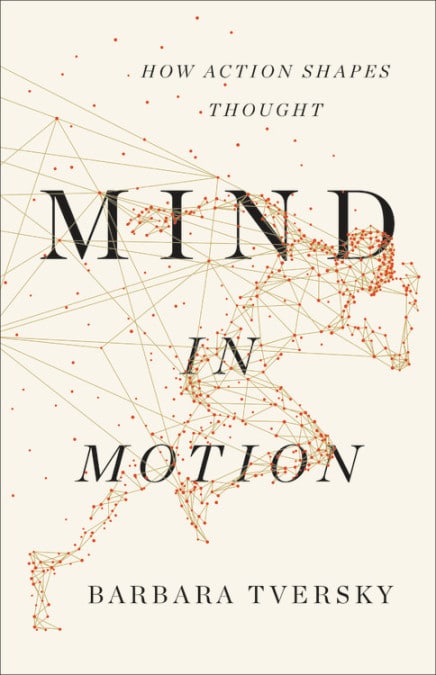Suppose I give you the name of a body part, and ask you to list its main uses: I say legs, you say walking and running; I say ears, you say hearing. And if I say the brain? Well, that’s a no-brainer (so to speak); obviously the brain is for thinking. Of course, it does a bunch of other things, too; after all, when the brain ceases to function, we die — but clearly it’s where cognition happens.

BOOK REVIEW — “Mind in Motion: How Action Shapes Thought,” by Barbara Tversky (Basic Books, 384 pages).
Or is it? No one would argue that the brain isn’t vital for thinking — but quite a few 21st-century psychologists and cognitive scientists believe that the body, as well as the brain, is needed for thinking to actually happen. And it’s not just that the brain needs a body to keep it alive (that much is obvious), but rather, that the brain and the body somehow work together: it’s the combination of brain-plus-body that creates the mental world.
The latest version of this proposition comes from Barbara Tversky, a professor emerita of psychology at Stanford University who also teaches at Columbia. Her new book, “Mind in Motion: How Action Shapes Thought,” is an extended argument for the interplay of mind and body in enabling cognition. She draws on many different lines of evidence, including the way we talk about movement and space, the way we use maps, the way we talk about and use numbers, and the way we gesture.
Tversky devotes a lengthy section to gesture, and for good reason: We do it incessantly. We do it naturally when we talk. But Tversky argues that gesturing is more than just a by-product of speech: it literally helps us think. She invites us to try this experiment: “Sit on your hands. Then explain out loud how to get from your house to the supermarket, train station, your office or school.” Turns out, it’s hard. When we can’t gesture, we have trouble speaking; we simply “can’t find the words,” she writes. (She notes that this isn’t just a thought experiment; it’s been confirmed in the lab.) Even people who have been blind from birth seem to rely on gesturing, she says.
And consider maps. In some sense, maps take gesturing to the next level. We gesture to indicate “over there” — but to pinpoint where over there, we need maps. And so, we create representations, in miniature, of the world around us. The maps can be physical or purely mental. And some of us are very good at it: Tversky reminds us of the well-known recent studies of London taxi drivers, who need to memorize the layout of some 25,000 streets and thousands of landmarks in the British capital (acquiring what cabbies refer to as “The Knowledge”). MRI studies found that all of that mental-mapping affected their brains, increasing the size of certain parts of the hippocampus.
Tversky argues that our ability to imagine the layout of objects in space is at the root of a more general — and more essential — skill. This ability, she believes, is the key to abstract thought. “Spatial thinking enables abstract thinking,” she writes.
The mind imagines the world, but the objects of the mind are not physical objects. What are they? We might call them ideas; psychologists often call them representations. The important thing is their astounding versatility: we can manipulate them, change them, play with them. They can become “symbols in mathematics, words in poetry, particles in physics, molecules in chemistry, buildings in a neighborhood, dancers on a stage,” she writes.
Sometimes the mind-body link is more subtle, as with “mental rotation” — the act of flipping objects in our imagination. We can see, in our mind’s eye, that if we take a lower-case b and flip it around a vertical axis, it becomes a lower-case d, while an o or a w remain unchanged. Though we perform these flips in our minds, it turns out that doing so also activates the motor areas of our brains — the areas we’d use if we were actually rotating something. As well, we’re better at performing mental rotations when we do pretend-rotations with our hands at the same time.
We can not only imagine things being rearranged in space, we can imagine things at various positions in time. We reflect on what happened and what could have happened, and we imagine what’s to come. At first this might seem to be a purely mental task — but it turns out that we use the same kind of language to talk about time that we use to talk about space. In some sense, we explore time with our minds just as we explore space with our bodies. (And presumably we’ve been doing so for centuries — in other words, since long before Einstein showed us that space and time are connected.) Most of us conceive of the future laying “in front” of us, and the past “behind,” though Tversky points out that the Aymara people of the South American Andes imagine it the other way around.
What seems to be universal is the way we imagine time in a linear fashion. Tversky intuits that her readers may be wondering about cyclical conceptions of time (think of all the things that recur every day, like our various meals, or every year, like the seasons). And what about Eastern cultures, which we’re often told have a more cyclical perspective? But Tversky has collected data from China, and it matches the Western form: “Chinese participants responded the same as Americans, overwhelmingly creating linear representations of cyclical events,” she writes. (And then there’s what Tversky calls the “Famous Ambiguous Question”: What does it mean when we receive a memo that says that Wednesday’s meeting “has been moved forward two days”? Apparently half of us take it to mean the meeting has been moved to Monday, half of us presume it means Friday.)
All of this is interesting, but I wish Tversky had more clearly positioned these findings within the larger history of cognitive science — especially because this body-inclusive approach to cognition isn’t brand new. It goes by various names in the literature — embodied cognition, enactivism, extended mind — none of which appear in Tversky’s index. In a similar vein, Tversky outlines what she calls a “mental spatial framework,” which sounds very similar to what other scholars call “mental modelling.” Perhaps they’re not exactly synonymous, but we’re not told one way or the other. Along with Tversky’s new terminology, there are new laws — nine “cognitive laws,” conveniently collected in a list immediately following the book’s final page. There’s nothing wrong with organizing ideas into laws, but as someone who’s read many such books, I can testify that they don’t always become widely adopted.
And speaking of endings: On the book’s final page — indeed its last sentence —we’re presented with a seemingly important idea, along with still more new terminology. We’re introduced to the word “spraction,” defined as “actions in space that create abstractions” (italics in the original). It seems a bit late in the game for such a move, and one wonders if this term is likely to catch on.
In the end, though, these are more eccentricities than flaws. Despite its oddities, “Mind in Motion” is a compelling journey through the world of cognition — a tour that leaves us with a renewed respect for the connections between the body and the mind, and how the two act together when we imagine, describe, and experience the world.
Dan Falk (@danfalk) is a science journalist based in Toronto. His books include “The Science of Shakespeare” and “In Search of Time.”











Comments are automatically closed one year after article publication. Archived comments are below.
My husband, who was born with little use of his arms and legs, moves his head and body to gesture, it’s that integral a part of communication. He’s pretty effective with it, too, but also struggles to give me directions (get that bug in front of you, to the right, up, etc) when he can’t actually point to the thing.
He doesn’t think in ‘pointing’ or waving a hand or an arm, however, and as a writer has noticed that he needs to add those things in specifically because they are foreign to him. To him, gesturing is nodding, pointing with his chin, etc.
There is a disjunction between Tversky’s insistence that gesture is required for direction-giving (I tried it it with hands under and it’s easy) and here picture of the mind-map in virtual space which clearly doesn’t need it. I guess you’ld have to read the book to see if the big picture is better but the extracts used in this review are not promising.
I suggest that if a participant’s goal at the outset is to disprove a theory, then the experiment is flawed. I do agree that a more thorough reading is required before drawing meaningful conclusions.